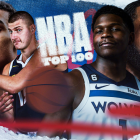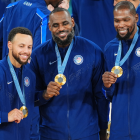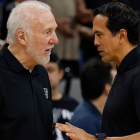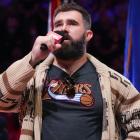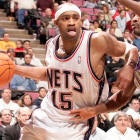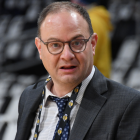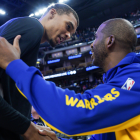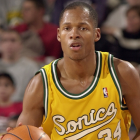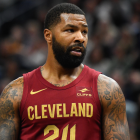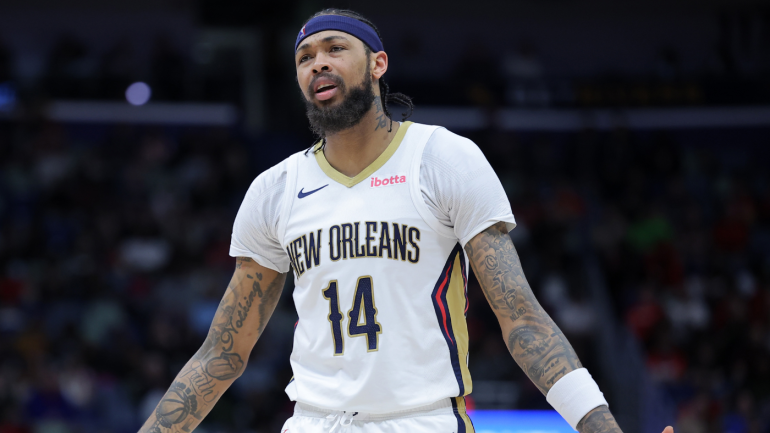
Brandon Ingram has, for the overwhelming majority of his career, carried significant trade value. Paul George openly said he wanted to join the Lakers in 2017. The Lakers did not offer Ingram coming off of his rookie season. Los Angeles did make him the centerpiece of a mega trade two years later, but it was for a then-26-year-old Anthony Davis, whose value was so significant at the time that ESPN's Zach Lowe declared that a Davis trade "might be the single most important trade of an NBA veteran since the Lakers acquired Kareem Abdul-Jabbar from Milwaukee in 1975." In 2022, when Kevin Durant was seemingly available for the taking, reports indicated that New Orleans was not willing to send him to Brooklyn.
This wasn't some flash in the pan. These were three distinct moments in Ingram's career, each of which carried legitimate reasons to question his value. He barely shot 40% from the field in averaging 9.4 points as a rookie. The season before he was traded for Davis ended due to a blood clot, the condition that ended Chris Bosh's career. He'd just missed 27 games in the 2021-22 season when the Pelicans held him out of Durant talks. This was a consistent valuation from multiple teams. For the first six or seven years of his career, the NBA treated Ingram like a superstar, or at least someone with the potential to become one. So why does it seem like nobody wants him now?
That might be an exaggeration. It might not be. The Pelicans more or less need to trade him. They just added another shot-creator in Dejounte Murray. They are going to give Trey Murphy a hefty rookie extension and are already paying Zion Williamson the max. Herb Jones is too important defensively to come off of the bench. There isn't a starting job available in New Orleans anymore except at center, which is currently a gaping hole. The Pelicans will need to trade someone to get a big. Ingram is the logical trade candidate. Even if that center hole didn't exist, the luxury tax sure does. You can't pay everybody. Keeping Murray, Murphy, Williams, Jones, C.J. McCollum, Ingram and a center is simply not feasible. That we're talking about a small-market New Orleans team that historically goes to great lengths to avoid the luxury tax is just the cherry on top. Someone has to go. It should be Ingram.
So where as the rumors? The Hawks needed wings, right? Well, The Athletic's Will Guillory reported that Atlanta didn't want him. Of course, we didn't even really need that reporting because these teams literally already traded once this offseason when Murray went to New Orleans. If the Hawks wanted Ingram, they could have had him then and there. The Warriors have pursued multiple high-level scorers this offseason including Paul George and Lauri Markkanen, but The Athletic's Anthony Slater wrote that he "would not expect" Golden State to trade for Ingram. The Sacramento Kings might have been interested a week ago. With DeMar DeRozan in place, they have likely moved on. As of this writing, Ingram has not been connected to any known suitors through substantive reporting. That includes two teams Guillory and others have cited as possible fits: the Cleveland Cavaliers, given their glut of guards and centers, and the Orlando Magic, who were stellar defensively last season but lacking on offense.
So what changed? Why has the entire NBA seemingly lost interest in a 26-year-old former All-Star playing the league's scarcest position? The short answer is money. Ingram is eligible for a four-year, $208 million contract extension this offseason. He reportedly wants that max money. The Pelicans are not interested in giving it to him. Neither were the Hawks, according to Guillory. Someone might be in 2025 free agency. It's far too early to make such predictions now, without knowing who will have cap space and what sort of season Ingram might have. It's safe to say that Ingram, at the very least, no longer falls into the automatic max category of contract negotiations.
There was a time that he would have. Ingram looks the part of a superstar. He scores a lot of points. His shooting numbers are relatively efficient. His combination of physical dimension and ball skills are about as close to Kevin Durant's as any other wing in the NBA, and wings are in remarkably short supply. There's a reason Mikal Bridges just got traded for five first-round picks and it wasn't just his cheap contract.
Look under the hood on Ingram and things start to get murkier. Most catch-all metrics dislike him. He just ranked 60th in EPM, 66th in VORP, 71st in WS/48 minutes and 125th in LEBRON, to give you a quick sampling. He's never been as consistent as his skills and physical traits suggest he should be. He has, at times, flashed tremendous defensive potential through his size, athleticism and length. Most of the time? He's average. The Lakers experimented with him as a point guard early in his career, and the results were promising. His talent as a passer is unquestionable. His interest in passing comes and goes. Ingram mostly just wants to take mid-range jumpers. After he showed real strides in terms of shot-selection in his first two years as a Pelican, his 3-point attempt rate over the past two seasons is down to 21.9%. His slow release might prevent him from ever shooting quite as many 3-pointers as he should. The 3.9 per game he's attempted over the past three seasons is unacceptable. That's less than Nikola Vucevic took last season.
There's something to the idea that players like Ingram lose value through sample size. A lot of his value came through projection. Players who look like superstars have an easier time convincing teams that they can still become one after their third year than their eighth. Franz Wagner just got a max rookie extension, after all. The bloom might just be off the rose here. Ingram isn't an upside anymore. He's just a player, a very good player, perhaps, but a known quantity on balance. To be frank, though, that hasn't stopped teams from maxing out their own prime players before. Zach LaVine got the max. Bradley Beal got the max. Tobias Harris got the max. NBA dogma has long-been "pay him now, figure it out later." You can always trade him down the line, right?
Well if the Pelicans could trade Ingram later, they'd probably be having an easier time trading him now. If New Orleans or any other team maxes Ingram here and now, there's a good chance he's unmovable for the duration of that contract. That's what's happening to LaVine right now, though injuries are a big part of that. The difference between the two is timing. The Bulls paid LaVine in 2022, before the 2023 CBA was written and ushered in a new era of fiscal responsibility around the NBA.
You're likely familiar with the harshest restrictions created by the luxury-tax aprons by now, and this offseason has, in many ways, been defined by the fear they've instilled in just about every team in the NBA. Paul George and Klay Thompson are playing for new teams because of these aprons. George was the only player to change teams on a four-year contract bigger than the mid-level exception in free agency. Only 29 total players signed for three years or more. De'Anthony Melteon is the only player to get a full mid-level contract... and he signed for one year. The Denver Nuggets are the only team ever to use the taxpayer mid-level exception under this new system, and they just lost a starter to the second apron. Every player class has been affected here. For the first time since the max contract was introduced in the 1999 CBA, that even includes the absolute top of the market.
Sign a bad max deal in 2017 and there are ways out of it. Russell Westbrook played for five teams during his five-year super-max that ended in 2023. Sometimes you'd find a sucker that overvalued your guy. Sometimes you'd swap him for another bad contract. Sometimes you even had to pay draft picks to get off him. But it was always doable.
But now? Money is so tight around the league that teams are pinching pennies even on role players. If you get a max deal wrong in 2024, that's enough to ruin your books for years to come. Why do you think there's been so little interest in Trae Young on the trade market? Why were there Karl-Anthony Towns rumors leading up to Minnesota's Western Conference finals run? If you're paying someone max money in 2024, he'd better be producing at the level of a max player, because if he's not, that contract cripples your pursuit of depth. That is especially true of players in the Ingram class who are likelier to be a No. 3 option than a No. 1.
Just look at the Michael Porter Jr. contract in Denver. The Nuggets paid him for the same reasons so many teams have wanted Ingram. He looks like a superstar. He has the size, he has the shooting, he has all of the classic traits that teams so desperately want. But he's averaged around 14 points per game over the past two postseasons. The Nuggets have lost Bruce Brown and Kentavious Caldwell-Pope in part because of the cap flexibility Porter has cost them. You cannot pay an offense-centric player max money if he isn't going to score. Minnesota had this problem with Towns against Dallas. The Nuggets signed Porter well before these rules came to be. He might be their next financial casualty. Paying Aaron Gordon is going to be a higher priority. His defense and role-player skills on offense at least give him a higher floor. That's probably why Rudy Gobert will outlast Towns in Minnesota. If you aren't going to be your team's offensive engine like Nikola Jokic in Denver or Anthony Edwards in Minnesota, there simply isn't enough room left in the budget to fill out the roster with viable role players if you're also paying an underperforming scorer max money. And everybody knows this. It's informing Ingram's light market right now. If he's not a top-level scorer for New Orleans and he hasn't committed to doing the little things for them either, then why would paying him go any differently for anyone else?
Teams are still willing to hand out max rookie extensions on potential, but doing so isn't as risky. Aside from the upside that comes with youth and the inherent tradability that accompanies it, the rookie max, barring Rose Rule escalators that are only accessible to proven stars, only counts for 25% of the salary cap in the first season. That's a far easier pill to swallow than the 30% players in Ingram's age range get or the 35% players with 10 or more years of experience can sign for. Maxes for players like Wagner, Scottie Barnes and Cade Cunningham will probably still be the norm, at least for now. But teams are going to draw lines in the sand on players coming up on their third contract. Nobody's getting 30% of the cap on potential anymore. You're worth it or you aren't.
Ingram is the first high-profile example of this phenomenon. Others will come too. Julius Randle becomes extension-eligible on Aug. 5. The Knicks are asking themselves the same questions that the Pelicans are right now, though in fairness, they have a clearer path to championship contention right now and an owner far more willing to spend, so there's a bit more flexibility there even with OG Anunoby already on a giant contract and big ones looming for Jalen Brunson and Mikal Bridges as well. Even the Knicks can't afford to pay Anunoby, Randle and all four Villanova players forever without incurring the second apron's wrath. One of those players isn't going to be on the team in two years unless the Knicks have hoisted a trophy by then. Randle, by far, is the likeliest casualty. Porter is in that situation in Denver. Towns is in Minnesota. Either Darius Garland or Jarrett Allen will be in Cleveland. Perhaps both. If there's any question about whether or not you're worth a 30% max anymore, you probably aren't. Cleveland is paying Donovan Mitchell and Evan Mobley. They're not paying four max-ish contracts and they might not be willing to pay three.
So what happens to these old-world max players in this brave new one the NBA is adjusting to? Maybe some team with no max players plucks one from one of the teams with three or four, but that doesn't seem especially likely. After all, if the Pistons wanted Brandon Ingram, wouldn't they just trade for him now? The last things teams want to do right now is throw off the financial balance of a team they haven't even built yet. Caution is the name of the game right now, so unless a player in that Ingram/Porter/Towns class is truly somebody's missing piece, they're probably not just getting paid elsewhere.
It's significantly likelier that we're just going to have to recalibrate what we consider a max player, and more importantly, what we consider players like Ingram whom the league no longer considers worthy of a max. There's a worthwhile comp here in one of his new teammates, at least as long as he remains with the Pelicans.
Dejounte Murray had significant positive trade value. He just netted two first-round picks, a recent lottery pick and a valuable veteran in a trade. Is Ingram better than Murray? Maybe by a bit, but they're in a similar range. They're both one-time All-Stars who don't shoot enough 3s, primarily create in the mid-range and have shown a ton of defensive upside without thriving on that end of the floor consistently. But Murray had value on a contract that will pay him roughly $28 million over the next four seasons, a bit more than half of what Ingram is asking for.
Maybe Ingram is just a $30 million per year player now instead of a $50 million per year player. Maybe that's the going rate for star talent without all-around star production. Even that accounts for upside to an extent. It's around what Jrue Holiday is going to earn on his extension, and Holiday, like Murray, carried more trade value last offseason than Ingram seems to right now. No rational actor would rather bring Ingram into the playoffs than Holiday tomorrow. Holiday is older and will decline by the end of his current deal. Ingram may not. There's value in between a young-ish known quantity.
It seems a safe guess right now that Ingram won't be interested in a $30 million per year extension. That puts New Orleans in a bit of a bind. No team is going to give up significant assets for him without sensing that they can extend him at a reasonable price. The Pelicans can't take the chance of signing him and figuring him out later given just how deep into the tax he'd take them as soon as the 2025-26 season. If he's staying put, some other core piece has to go. McCollum might be a viable stopgap in this regard, especially if he could net a center on an expiring contract back. But the core problem of having five guards and forwards for four spots still remains. Trading Murphy or letting him enter restricted free agency is a non-starter.
All of this opens the door to a lot of scary outcomes for the Pelicans. They might have to let him walk for nothing. They might be so scared of that prospect that they overpay him without a plan. Eventually, players like Ingram are going to learn from Ingram's example. The market will recalibrate because it always does. But right now, teams are adjusting to the new rules faster than players and their agents will. Ingram is not a max player anymore under these new rules, but as long as he thinks of himself as one, he's going to put pressure on the Pelicans to pay him as such.









